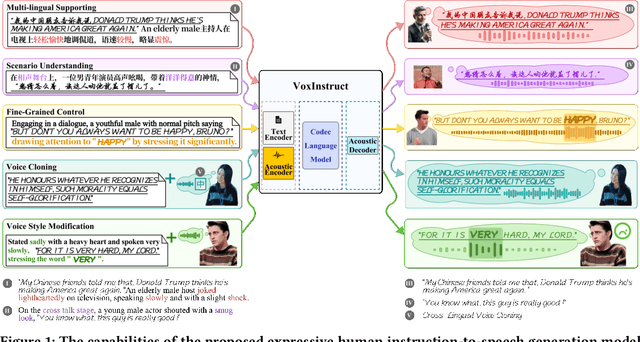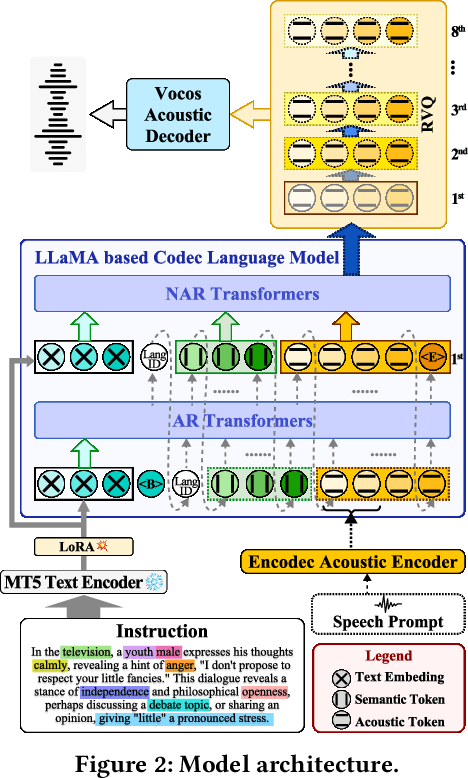Zeyu Jin
Deep Audio Watermarks are Shallow: Limitations of Post-Hoc Watermarking Techniques for Speech
Apr 15, 2025Abstract:In the audio modality, state-of-the-art watermarking methods leverage deep neural networks to allow the embedding of human-imperceptible signatures in generated audio. The ideal is to embed signatures that can be detected with high accuracy when the watermarked audio is altered via compression, filtering, or other transformations. Existing audio watermarking techniques operate in a post-hoc manner, manipulating "low-level" features of audio recordings after generation (e.g. through the addition of a low-magnitude watermark signal). We show that this post-hoc formulation makes existing audio watermarks vulnerable to transformation-based removal attacks. Focusing on speech audio, we (1) unify and extend existing evaluations of the effect of audio transformations on watermark detectability, and (2) demonstrate that state-of-the-art post-hoc audio watermarks can be removed with no knowledge of the watermarking scheme and minimal degradation in audio quality.
DiTSE: High-Fidelity Generative Speech Enhancement via Latent Diffusion Transformers
Apr 13, 2025Abstract:Real-world speech recordings suffer from degradations such as background noise and reverberation. Speech enhancement aims to mitigate these issues by generating clean high-fidelity signals. While recent generative approaches for speech enhancement have shown promising results, they still face two major challenges: (1) content hallucination, where plausible phonemes generated differ from the original utterance; and (2) inconsistency, failing to preserve speaker's identity and paralinguistic features from the input speech. In this work, we introduce DiTSE (Diffusion Transformer for Speech Enhancement), which addresses quality issues of degraded speech in full bandwidth. Our approach employs a latent diffusion transformer model together with robust conditioning features, effectively addressing these challenges while remaining computationally efficient. Experimental results from both subjective and objective evaluations demonstrate that DiTSE achieves state-of-the-art audio quality that, for the first time, matches real studio-quality audio from the DAPS dataset. Furthermore, DiTSE significantly improves the preservation of speaker identity and content fidelity, reducing hallucinations across datasets compared to state-of-the-art enhancers. Audio samples are available at: http://hguimaraes.me/DiTSE
SpeakEasy: Enhancing Text-to-Speech Interactions for Expressive Content Creation
Apr 07, 2025Abstract:Novice content creators often invest significant time recording expressive speech for social media videos. While recent advancements in text-to-speech (TTS) technology can generate highly realistic speech in various languages and accents, many struggle with unintuitive or overly granular TTS interfaces. We propose simplifying TTS generation by allowing users to specify high-level context alongside their script. Our Wizard-of-Oz system, SpeakEasy, leverages user-provided context to inform and influence TTS output, enabling iterative refinement with high-level feedback. This approach was informed by two 8-subject formative studies: one examining content creators' experiences with TTS, and the other drawing on effective strategies from voice actors. Our evaluation shows that participants using SpeakEasy were more successful in generating performances matching their personal standards, without requiring significantly more effort than leading industry interfaces.
Everyone-Can-Sing: Zero-Shot Singing Voice Synthesis and Conversion with Speech Reference
Jan 23, 2025Abstract:We propose a unified framework for Singing Voice Synthesis (SVS) and Conversion (SVC), addressing the limitations of existing approaches in cross-domain SVS/SVC, poor output musicality, and scarcity of singing data. Our framework enables control over multiple aspects, including language content based on lyrics, performance attributes based on a musical score, singing style and vocal techniques based on a selector, and voice identity based on a speech sample. The proposed zero-shot learning paradigm consists of one SVS model and two SVC models, utilizing pre-trained content embeddings and a diffusion-based generator. The proposed framework is also trained on mixed datasets comprising both singing and speech audio, allowing singing voice cloning based on speech reference. Experiments show substantial improvements in timbre similarity and musicality over state-of-the-art baselines, providing insights into other low-data music tasks such as instrumental style transfer. Examples can be found at: everyone-can-sing.github.io.
Code Drift: Towards Idempotent Neural Audio Codecs
Oct 14, 2024Abstract:Neural codecs have demonstrated strong performance in high-fidelity compression of audio signals at low bitrates. The token-based representations produced by these codecs have proven particularly useful for generative modeling. While much research has focused on improvements in compression ratio and perceptual transparency, recent works have largely overlooked another desirable codec property -- idempotence, the stability of compressed outputs under multiple rounds of encoding. We find that state-of-the-art neural codecs exhibit varied degrees of idempotence, with some degrading audio outputs significantly after as few as three encodings. We investigate possible causes of low idempotence and devise a method for improving idempotence through fine-tuning a codec model. We then examine the effect of idempotence on a simple conditional generative modeling task, and find that increased idempotence can be achieved without negatively impacting downstream modeling performance -- potentially extending the usefulness of neural codecs for practical file compression and iterative generative modeling workflows.
DMDSpeech: Distilled Diffusion Model Surpassing The Teacher in Zero-shot Speech Synthesis via Direct Metric Optimization
Oct 14, 2024Abstract:Diffusion models have demonstrated significant potential in speech synthesis tasks, including text-to-speech (TTS) and voice cloning. However, their iterative denoising processes are inefficient and hinder the application of end-to-end optimization with perceptual metrics. In this paper, we propose a novel method of distilling TTS diffusion models with direct end-to-end evaluation metric optimization, achieving state-of-the-art performance. By incorporating Connectionist Temporal Classification (CTC) loss and Speaker Verification (SV) loss, our approach optimizes perceptual evaluation metrics, leading to notable improvements in word error rate and speaker similarity. Our experiments show that DMDSpeech consistently surpasses prior state-of-the-art models in both naturalness and speaker similarity while being significantly faster. Moreover, our synthetic speech has a higher level of voice similarity to the prompt than the ground truth in both human evaluation and objective speaker similarity metric. This work highlights the potential of direct metric optimization in speech synthesis, allowing models to better align with human auditory preferences. The audio samples are available at https://dmdspeech.github.io/.
Improving Generalization of Speech Separation in Real-World Scenarios: Strategies in Simulation, Optimization, and Evaluation
Aug 28, 2024



Abstract:Achieving robust speech separation for overlapping speakers in various acoustic environments with noise and reverberation remains an open challenge. Although existing datasets are available to train separators for specific scenarios, they do not effectively generalize across diverse real-world scenarios. In this paper, we present a novel data simulation pipeline that produces diverse training data from a range of acoustic environments and content, and propose new training paradigms to improve quality of a general speech separation model. Specifically, we first introduce AC-SIM, a data simulation pipeline that incorporates broad variations in both content and acoustics. Then we integrate multiple training objectives into the permutation invariant training (PIT) to enhance separation quality and generalization of the trained model. Finally, we conduct comprehensive objective and human listening experiments across separation architectures and benchmarks to validate our methods, demonstrating substantial improvement of generalization on both non-homologous and real-world test sets.
VoxInstruct: Expressive Human Instruction-to-Speech Generation with Unified Multilingual Codec Language Modelling
Aug 28, 2024



Abstract:Recent AIGC systems possess the capability to generate digital multimedia content based on human language instructions, such as text, image and video. However, when it comes to speech, existing methods related to human instruction-to-speech generation exhibit two limitations. Firstly, they require the division of inputs into content prompt (transcript) and description prompt (style and speaker), instead of directly supporting human instruction. This division is less natural in form and does not align with other AIGC models. Secondly, the practice of utilizing an independent description prompt to model speech style, without considering the transcript content, restricts the ability to control speech at a fine-grained level. To address these limitations, we propose VoxInstruct, a novel unified multilingual codec language modeling framework that extends traditional text-to-speech tasks into a general human instruction-to-speech task. Our approach enhances the expressiveness of human instruction-guided speech generation and aligns the speech generation paradigm with other modalities. To enable the model to automatically extract the content of synthesized speech from raw text instructions, we introduce speech semantic tokens as an intermediate representation for instruction-to-content guidance. We also incorporate multiple Classifier-Free Guidance (CFG) strategies into our codec language model, which strengthens the generated speech following human instructions. Furthermore, our model architecture and training strategies allow for the simultaneous support of combining speech prompt and descriptive human instruction for expressive speech synthesis, which is a first-of-its-kind attempt. Codes, models and demos are at: https://github.com/thuhcsi/VoxInstruct.
VDGD: Mitigating LVLM Hallucinations in Cognitive Prompts by Bridging the Visual Perception Gap
May 24, 2024Abstract:Recent interest in Large Vision-Language Models (LVLMs) for practical applications is moderated by the significant challenge of hallucination or the inconsistency between the factual information and the generated text. In this paper, we first perform an in-depth analysis of hallucinations and discover several novel insights about how and when LVLMs hallucinate. From our analysis, we show that: (1) The community's efforts have been primarily targeted towards reducing hallucinations related to visual recognition (VR) prompts (e.g., prompts that only require describing the image), thereby ignoring hallucinations for cognitive prompts (e.g., prompts that require additional skills like reasoning on contents of the image). (2) LVLMs lack visual perception, i.e., they can see but not necessarily understand or perceive the input image. We analyze responses to cognitive prompts and show that LVLMs hallucinate due to a perception gap: although LVLMs accurately recognize visual elements in the input image and possess sufficient cognitive skills, they struggle to respond accurately and hallucinate. To overcome this shortcoming, we propose Visual Description Grounded Decoding (VDGD), a simple, robust, and training-free method for alleviating hallucinations. Specifically, we first describe the image and add it as a prefix to the instruction. Next, during auto-regressive decoding, we sample from the plausible candidates according to their KL-Divergence (KLD) to the description, where lower KLD is given higher preference. Experimental results on several benchmarks and LVLMs show that VDGD improves significantly over other baselines in reducing hallucinations. We also propose VaLLu, a benchmark for the comprehensive evaluation of the cognitive capabilities of LVLMs.
A Closer Look at the Limitations of Instruction Tuning
Feb 03, 2024Abstract:Instruction Tuning (IT), the process of training large language models (LLMs) using instruction-response pairs, has emerged as the predominant method for transforming base pre-trained LLMs into open-domain conversational agents. While IT has achieved notable success and widespread adoption, its limitations and shortcomings remain underexplored. In this paper, through rigorous experiments and an in-depth analysis of the changes LLMs undergo through IT, we reveal various limitations of IT. In particular, we show that (1) IT fails to enhance knowledge or skills in LLMs. LoRA fine-tuning is limited to learning response initiation and style tokens, and full-parameter fine-tuning leads to knowledge degradation. (2) Copying response patterns from IT datasets derived from knowledgeable sources leads to a decline in response quality. (3) Full-parameter fine-tuning increases hallucination by inaccurately borrowing tokens from conceptually similar instances in the IT dataset for generating responses. (4) Popular methods to improve IT do not lead to performance improvements over a simple LoRA fine-tuned model. Our findings reveal that responses generated solely from pre-trained knowledge consistently outperform responses by models that learn any form of new knowledge from IT on open-source datasets. We hope the insights and challenges revealed inspire future work.
 Add to Chrome
Add to Chrome Add to Firefox
Add to Firefox Add to Edge
Add to Edge